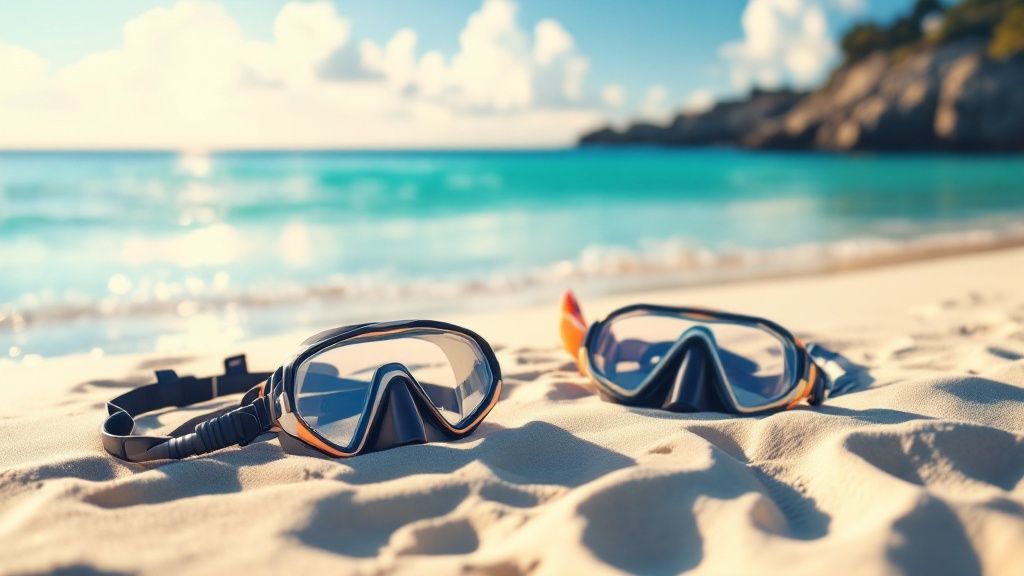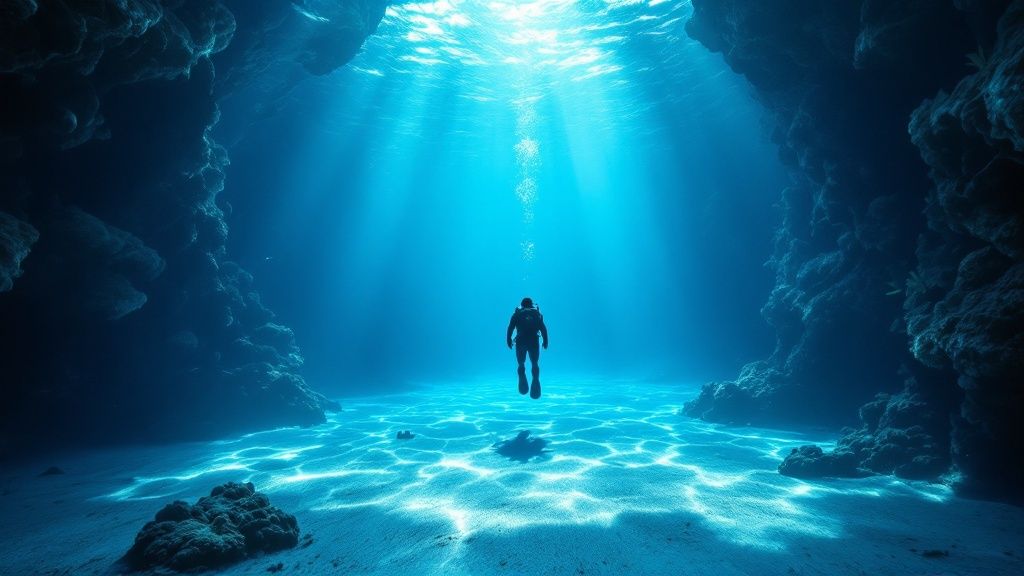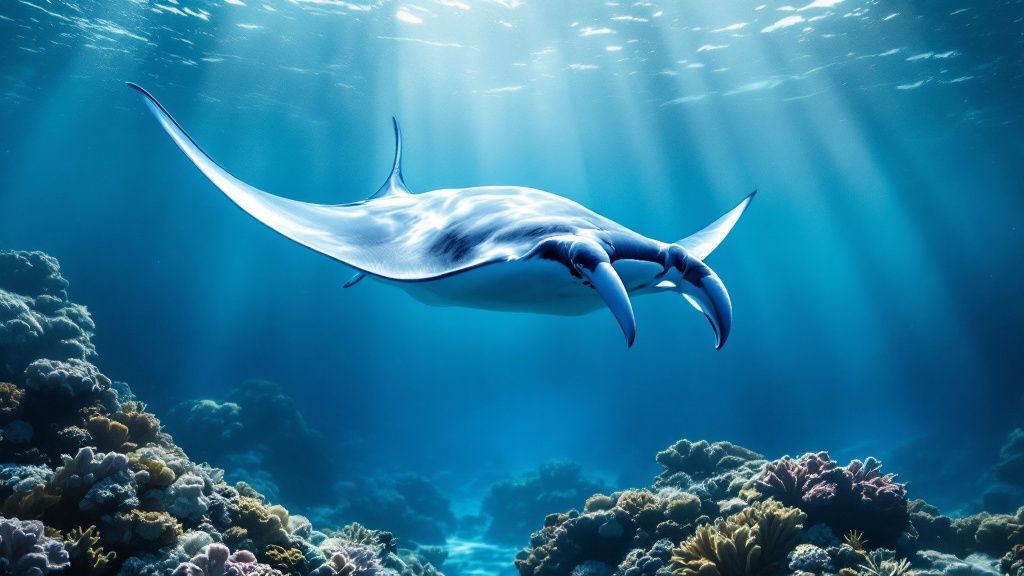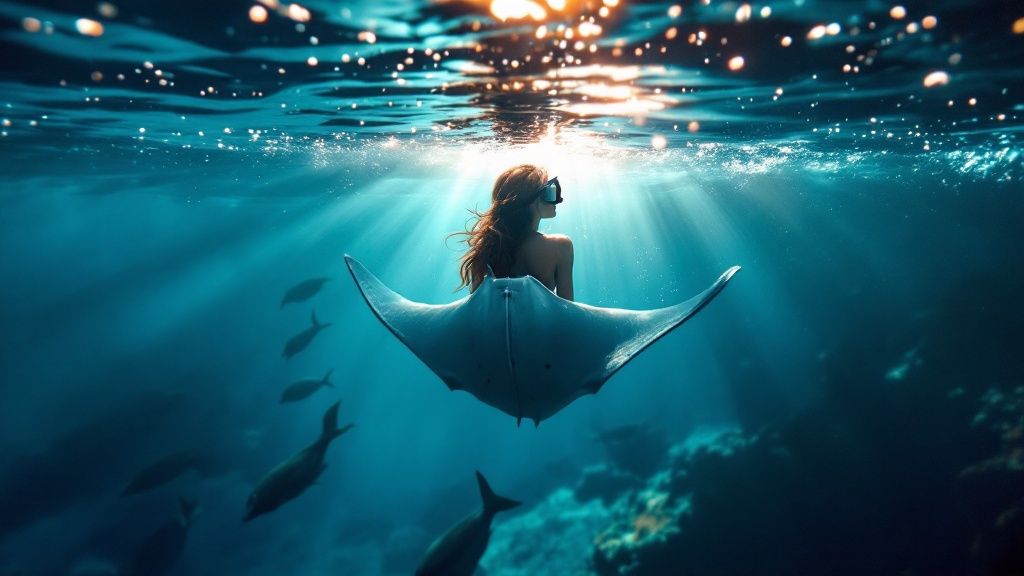Manta Ray Snorkeling: Ultimate Adventure
- Byron
- Apr 14
- 10 min read
The Mesmerizing World of Manta Ray Snorkeling

Imagine the thrill of floating on the ocean's surface, gazing down at the graceful ballet of manta rays gliding beneath you. Manta ray snorkeling offers an incredible opportunity to connect with these gentle giants, some with wingspans reaching an astonishing 20 feet. It's an experience that leaves a lasting impression, often described as truly magical.
Many snorkelers, even seasoned ones, find themselves speechless after a close encounter with these majestic creatures. The experience fosters a deep appreciation for the marine world and often inspires a newfound commitment to ocean conservation.
The Economic Impact of Manta Ray Tourism
Manta ray snorkeling isn't just a memorable experience; it's a significant contributor to local economies worldwide. The economic benefits of manta ray tourism far surpass those of fishing these magnificent creatures.
Manta ray tourism generates over $140 million annually across 23 countries. This revenue stream supports various activities, including snorkeling and diving, and benefits countries like Japan, Indonesia, the Maldives, and Australia. In stark contrast, fishing manta rays for their gill plates yields a meager return, estimated at only $442,000 annually in Indonesia. More detailed statistics can be found here: https://journals.plos.org/plosone/article?id=10.1371%2Fjournal.pone.0065051
Choosing the Right Manta Ray Snorkeling Experience
Finding a responsible tour operator who prioritizes ethical and sustainable manta ray interactions is crucial. Several companies offer exceptional tours, including Kona Honu Divers (https://konahonudivers.com/snorkeling-tours/manta-ray-snorkel/), Manta Ray Night Snorkel Hawaii (https://www.mantaraynightsnorkelhawaii.com/), Kona Snorkel Trips (https://konasnorkeltrips.com/snorkel-tours/manta-ray-snorkel-kona/), and Captain Cook Snorkeling Tours (https://www.captaincooksnorkelingtours.com/). These operators emphasize minimizing disturbances to the manta rays and their environment while providing unforgettable snorkeling adventures. Each destination boasts unique manta ray behaviors and viewing conditions, ensuring a diverse range of experiences.
Prime Destinations for Unforgettable Manta Encounters

From Hawaii's Kona coast to the Maldives' vibrant reefs, manta ray snorkeling opportunities are plentiful. Choosing the right spot involves considering several factors, as each location provides a unique blend of manta ray behaviors, water conditions, and overall experience. This guide explores some of the world's best locations for encountering these gentle giants.
Hawaii: The Nighttime Spectacle
Kona, Hawaii, offers a unique nighttime snorkeling experience. After sunset, specialized lights attract plankton, drawing in manta rays for a mesmerizing feeding frenzy. This creates a spectacular chance to observe these graceful creatures up close, often performing acrobatic backflips just below the surface. For a truly memorable adventure, check out Manta Ray Night Snorkel Hawaii and Kona Snorkel Trips. You can also explore their sitemap for other informative articles.
The Maldives: Crystal-Clear Encounters
The Maldives, known for pristine waters and abundant marine life, is a premier manta ray snorkeling destination. Crystal-clear lagoons offer exceptional visibility, allowing extended observation of these magnificent creatures in their natural habitat. The diverse coral reefs and vibrant fish populations further enrich the overall snorkeling experience.
Indonesia: Biodiversity Hotspot
Indonesia's rich biodiversity includes thriving manta ray populations, offering exciting snorkeling opportunities. The waters surrounding Bali and Komodo National Park boast regular sightings. These locations provide the chance to witness manta rays among other marine life, creating an immersive underwater adventure.
Ecuador: Home to Giants
Off the coast of Ecuador resides the world's largest known oceanic manta ray population, estimated at over 22,000 individuals. The nutrient-rich waters provide ample food, making it a haven for these giants. Despite legal protection against capture since 2010 in Ecuador and 2016 in Peru, threats from fishing activities like entanglement and bycatch remain. Conservation efforts are vital to the species' survival and support sustainable tourism. Learn more about these conservation efforts here.
Choosing Your Ideal Destination
The best destination ultimately depends on your preferences. Whether drawn to Kona's nighttime magic, the Maldives' pristine beauty, Indonesia's biodiversity, or Ecuador's sheer abundance, research is key. Consider factors like the best season to visit, typical manta ray behaviors, water conditions, and logistics to make informed decisions. Other reputable operators include Kona Honu Divers and Captain Cook Snorkeling Tours.
The table below compares some key aspects of these destinations to help you choose:
Manta Ray Snorkeling Destinations Comparison
This table compares key attributes of the world's top manta ray snorkeling destinations to help readers choose their ideal location.
Destination | Best Season | Type of Experience | Approximate Cost | Visibility | Success Rate |
|---|---|---|---|---|---|
Kona, Hawaii | Year-round, best May-November | Night Snorkeling | $100-$200 | Variable, dependent on lighting | High |
Maldives | November-April | Daytime Snorkeling | $50-$150 | Excellent | High |
Indonesia (Bali/Komodo) | April-November | Daytime Snorkeling | $75-$200 | Good to Excellent | Moderate to High |
Ecuador | June-October | Daytime Snorkeling | $150-$300 | Moderate | Moderate |
As you can see, each destination offers unique advantages. Kona provides the exceptional nighttime viewing experience, while the Maldives boasts incredible visibility. Indonesia provides the chance to see diverse marine life alongside manta rays, and Ecuador offers the possibility of seeing large numbers of these gentle giants. Consider your priorities and budget when making your decision.
Planning Your Dream Manta Ray Adventure

Turning your manta ray snorkeling dreams into reality starts with a solid plan. This means picking the perfect location, finding a responsible tour operator, and ensuring you're ready for anything the ocean throws your way. Being prepared includes having the right equipment, understanding the water conditions, and knowing how to handle potential challenges.
Choosing The Right Operator
A positive manta ray experience relies heavily on choosing an ethical tour operator. Look for companies like Kona Honu Divers and Captain Cook Snorkeling Tours that prioritize marine conservation. Asking about their certifications and practices is essential.
Avoid operators who promote interactions that could stress the manta rays, such as touching or chasing. These actions can disrupt their natural behaviors and negatively impact their well-being. Responsible interaction is key to a positive experience for both you and the manta rays.
Essential Gear And Preparation
Having the proper gear is vital for a comfortable and enjoyable manta ray snorkeling trip. A wetsuit is often recommended, particularly for nighttime excursions when water temperatures can drop. Fins and a mask are crucial for efficient swimming and clear underwater visibility. You can find other helpful information here: Manta Ray Night Snorkel's sitemap for other informative articles.
Preparing for various water conditions is also smart. If you're prone to seasickness, consider taking medication beforehand. This will help you fully enjoy the incredible experience without any discomfort. Kona Snorkel Trips offers additional valuable insights into preparing for your trip.
Budget And Booking
Think about the overall cost of your adventure, including the tour price, equipment rentals, transportation, and lodging. Booking in advance, especially during peak season, is highly recommended to secure your spot. This also gives you time to research different operators and compare what they offer.
The following table provides a helpful overview of essential gear for your manta ray snorkeling trip. It outlines the purpose of each item, whether it's required or optional, rental availability, and estimated cost.
Essential Gear for Manta Ray Snorkeling
Equipment Item | Purpose | Required/Optional | Rental Available? | Estimated Cost |
|---|---|---|---|---|
Mask | Clear underwater vision | Required | Yes | $10-$20 |
Snorkel | Breathing at the surface | Required | Yes | $5-$15 |
Fins | Efficient movement in the water | Required | Yes | $10-$20 |
Wetsuit | Warmth and buoyancy | Recommended | Yes | $20-$30 |
Underwater Camera | Capturing photos/videos | Optional | Sometimes | Variable |
Seasickness Medication | Preventing motion sickness | Optional | No | Variable |
Towel and Change of Clothes | Comfort after snorkeling | Recommended | No | N/A |
Having the necessary equipment contributes significantly to a comfortable and enjoyable experience. Remember to factor rental costs into your budget if you don’t own specific items.
By carefully considering these planning elements – from choosing a responsible operator to packing the right gear – you’re setting yourself up for an amazing manta ray snorkeling adventure. Thorough preparation not only enhances your enjoyment but also contributes to the safety and well-being of these magnificent creatures.
Kona's Magical Night Ballet: The Ultimate Manta Experience

Kona, Hawaii, is famous for its incredible nighttime manta ray snorkeling. This unique adventure, often called an underwater ballet, offers a rare chance to get up close and personal with these gentle giants. Drawing on insights from guides at Manta Ray Night Snorkel Hawaii and Kona Snorkel Trips, we'll dive into what makes this experience so special.
The Evolution of a Remarkable Tradition
This remarkable tradition started with a simple observation: plankton, the manta rays' main food source, are drawn to light. Clever tour operators used this knowledge to their advantage. They employed specialized lighting to attract plankton to the surface, which in turn, brought the manta rays, creating a spectacular feeding display for snorkelers to witness firsthand. You can also find more information in our article on blog posts related to manta ray snorkeling.
The Science Behind the Spectacle
The magic of Kona's manta ray snorkeling comes from the perfect blend of light, plankton, and manta ray behavior. The lights, usually fixed to boards or platforms, draw in massive amounts of plankton. This creates an irresistible feast for the manta rays, who perform graceful backflips and barrel rolls as they dine.
A Close Encounter with Gentle Giants
Picture yourself floating on the surface, watching enormous manta rays, some with wingspans of over 10 feet, glide just inches below. As shown in videos like this mesmerizing encounter, it's a truly awe-inspiring sight. These gentle giants often come incredibly close to snorkelers, creating an unforgettable connection.
However, the popularity of manta ray snorkeling highlights the need for responsible tourism. Overcrowding has become a problem in some popular locations. A survey revealed that 82% of snorkelers and divers in one area felt crowded by other snorkelers, and 78% felt crowded by boats. This can stress the manta rays and disrupt their natural behavior. You can find more statistics here. This underscores the need for sustainable tourism practices and regulations to protect these magnificent creatures and ensure a positive experience for everyone.
Tips for the Ultimate Manta Ray Snorkeling Experience
Choose the Right Operator: Opt for operators like Manta Ray Night Snorkel Hawaii and Kona Snorkel Trips committed to ethical practices and minimizing environmental impact.
The 'Campfire' Formation: Many operators employ a "campfire" formation where snorkelers hold onto a lit floating platform, creating a prime viewing spot for the manta rays feeding below.
Best Departure Locations: Boats usually depart from Keauhou Bay or Honokohau Harbor, known for their proximity to prime manta ray viewing areas like Manta Village.
Typical Tour Schedules: Most tours run in the evening, after sunset, coinciding with peak manta ray feeding times.
Capturing Footage: Waterproof cameras and GoPros are perfect for capturing the experience. Remember to savor the moment and avoid excessive flash photography. Some operators offer photography packages.
By following these tips and choosing a responsible operator like Captain Cook Snorkeling Tours, you're guaranteed a magical and unforgettable manta ray snorkeling experience.
Decoding Manta Behavior for Meaningful Encounters
Manta ray snorkeling offers a unique opportunity to connect with these magnificent creatures. It's more than just a viewing; it's about understanding their behavior. By learning to interpret their subtle cues, you can transform a simple snorkel trip into a truly meaningful encounter. This deeper understanding not only enriches your own experience, but also promotes responsible ocean stewardship. For those looking to enhance their manta ray experience, How to master your Manta Ray Night Snorkel offers valuable insights.
Understanding Manta Ray Communication
While seemingly silent, manta rays communicate through a complex language of body movements. A slow, graceful glide suggests a relaxed manta. Rapid movements and sharp turns, however, might indicate excitement or a potential threat. Learning to recognize these subtle cues allows snorkelers to anticipate the manta's behavior and appreciate the nuances of their interactions.
Feeding Behaviors: A Feast for the Senses
Manta rays are filter feeders, consuming vast quantities of plankton. They employ several fascinating feeding techniques. Chain feeding, where multiple mantas align to devour a dense plankton patch, is a truly remarkable spectacle. Another impressive behavior is barrel rolling, where the manta spirals vertically while feeding, showcasing its agility and feeding efficiency. These behaviors offer a glimpse into the sophisticated feeding strategies these creatures employ.
Cleaning Stations and Social Interactions
Coral reefs often feature cleaning stations, where mantas congregate to be cleaned by smaller fish. These stations act as social hubs, providing opportunities to observe interactions between mantas and other marine life. Mantas exhibit distinct personalities. Some are curious and playful, while others are more reserved. Observing these interactions at cleaning stations reveals the complex social dynamics within manta ray populations.
Responsible Viewing: Minimizing Our Impact
Responsible manta ray snorkeling involves positioning yourself for optimal viewing without disturbing the mantas' natural behavior. Maintaining a respectful distance, avoiding sudden movements, and refraining from touching them are crucial. This minimizes stress on the animals and ensures a positive experience for both the manta rays and the observer. Our actions in the water directly impact these vulnerable creatures, so prioritizing their well-being is essential.
Ethical tour operators like Kona Honu Divers and Captain Cook Snorkeling Tours provide valuable information on responsible manta ray interactions. By choosing responsible operators and adopting ethical viewing practices, we can shift our role from mere observer to engaged ocean steward, contributing to the long-term health and well-being of these gentle giants.
Conservation Through Connection: Responsible Encounters
Your manta ray snorkeling adventure offers a special opportunity: contributing to the conservation of these incredible animals. Every interaction, intentional or unintentional, has an impact. This section explores how to ensure your encounter benefits, rather than harms, these gentle giants. This knowledge helps you become a responsible ocean steward, working towards a future where manta rays flourish.
Understanding the Threats to Manta Rays
Manta rays face many threats, both natural and human-caused. Targeted fishing for their gill plates, accidental bycatch in other fisheries, habitat destruction, and climate change all contribute to declining populations. Their slow reproduction rate, with females birthing just one pup every few years, makes recovery from these threats even more difficult.
Bycatch, for instance, is a significant concern. Mantas can become entangled in fishing nets meant for other species, resulting in injury or death. This highlights the critical need for sustainable fishing practices and responsible tourism to lessen our impact.
Sustainable Tourism: A Force for Good
Thankfully, sustainable tourism provides a glimmer of hope. The revenue generated by manta ray snorkeling tourism can support vital research and conservation projects. This creates a cycle where responsible encounters directly protect these amazing creatures and their habitats.
Furthermore, responsible operators, such as Kona Honu Divers and Captain Cook Snorkeling Tours, actively engage in conservation initiatives, further expanding the positive influence of tourism.
Guidelines for Responsible Manta Ray Snorkeling
Maintain a Respectful Distance: Keep a safe distance, allowing the manta rays to swim freely without feeling threatened. Avoid chasing or cornering them.
No Touching: Never touch a manta ray. Their skin has a protective mucus layer essential for their immune system. Touching disrupts this layer, potentially exposing them to harmful bacteria and diseases.
Responsible Underwater Lighting: If you're on a night snorkel, follow your operator's instructions about underwater lights. Excessive or improper light use can disorient and stress the manta rays.
Choose Ethical Operators: Support tour operators like Manta Ray Night Snorkel Hawaii that prioritize manta ray conservation through sustainable practices. These operators often work with researchers and help collect valuable data.
Citizen Science: Many organizations welcome citizen scientists, encouraging snorkelers to contribute identification photos. Your vacation photos can become important tools for researchers, helping track manta ray populations and understand their movements. Find out more in our article on important pages.
These guidelines create a positive experience for both you and the manta rays, supporting the long-term well-being of these incredible animals and their marine environment.
Making a Difference: One Snorkel at a Time
By following these simple guidelines and supporting ethical tour operators, you can make your manta ray snorkeling experience an act of conservation. Every responsible encounter safeguards these gentle giants, building a brighter future for manta rays around the world.
Book your unforgettable Manta Ray Night Snorkel Kona Hawaii Tour and experience the magic of these gentle giants while contributing to their conservation! Dive into the adventure!
Comments